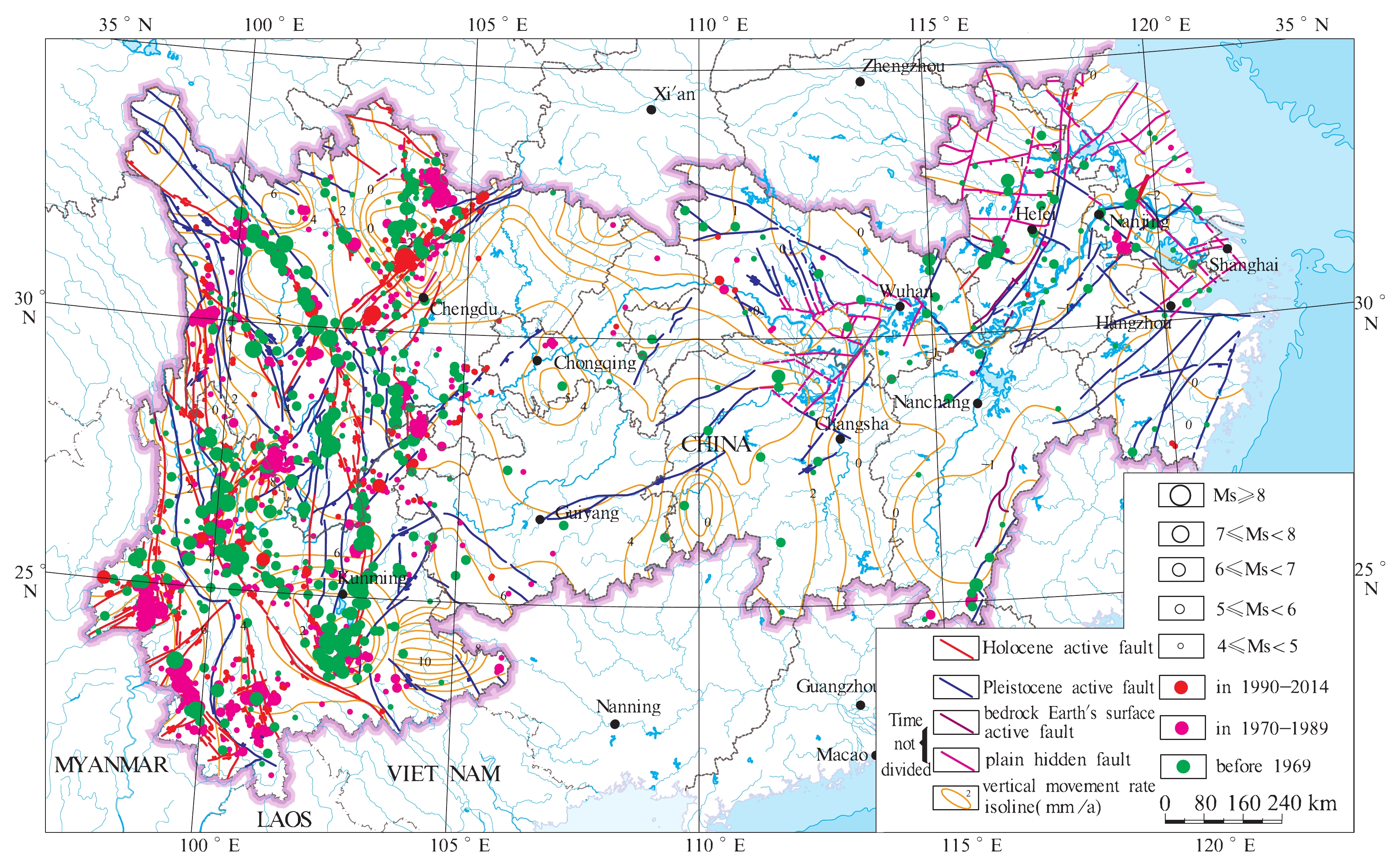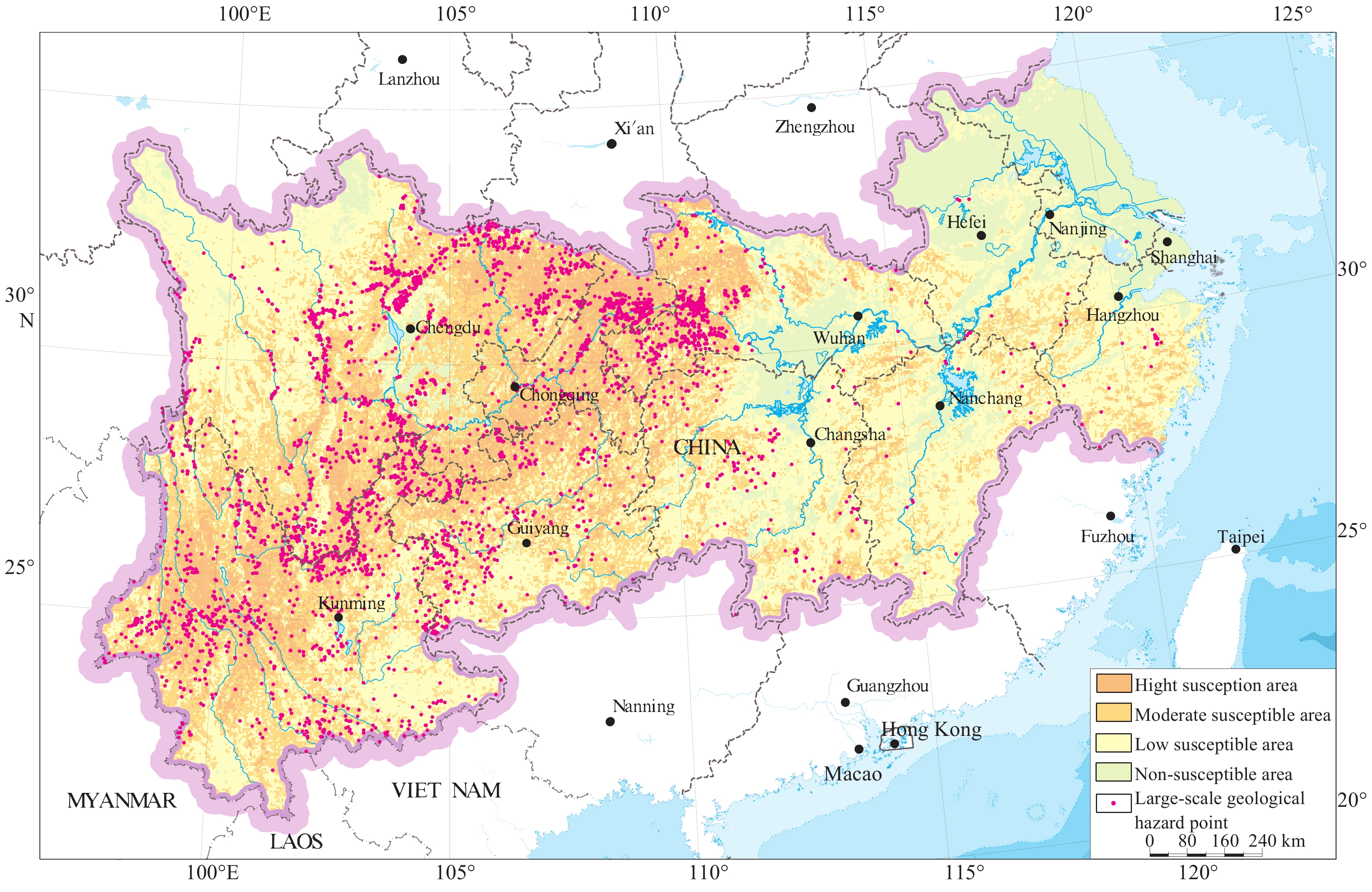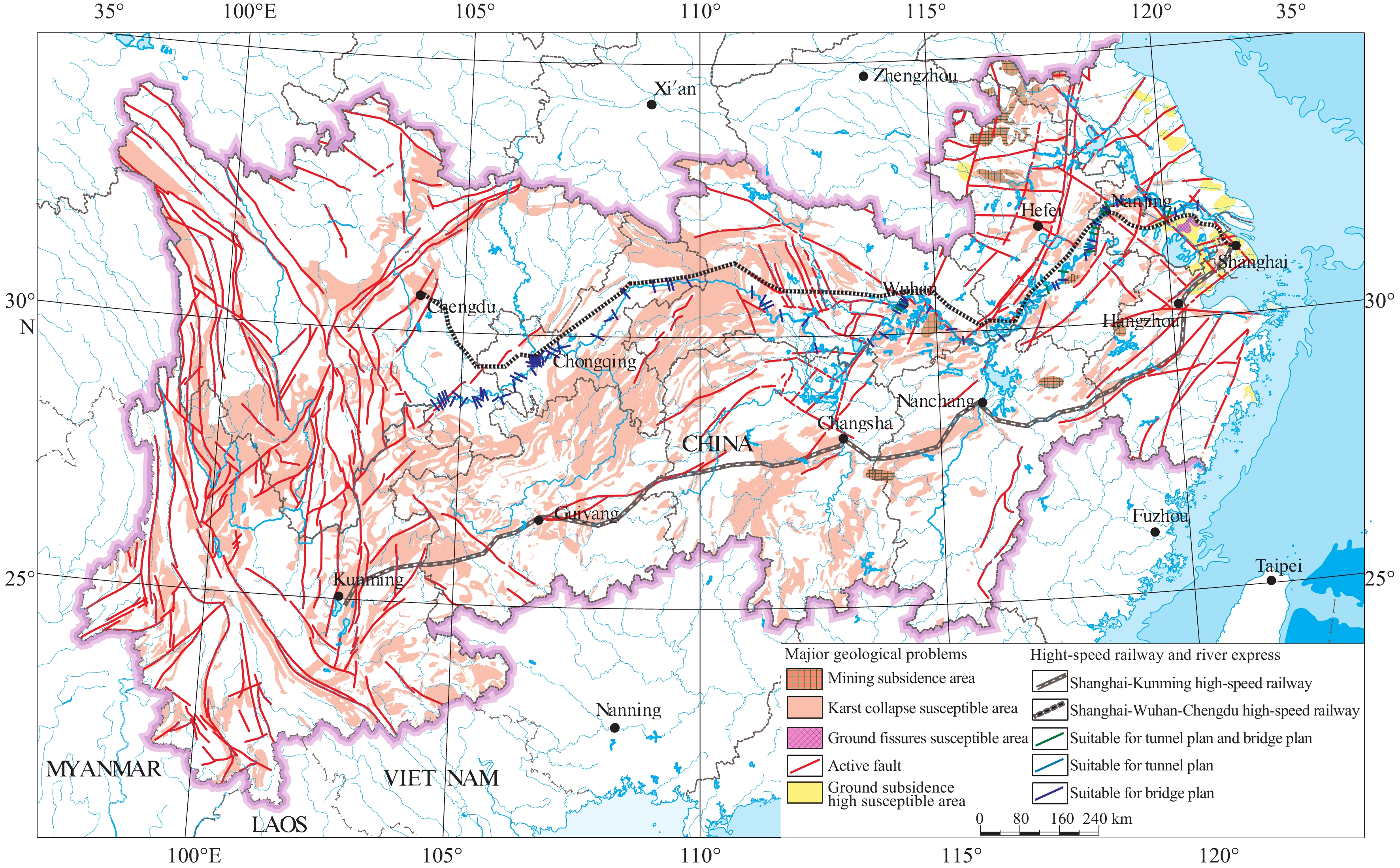| Citation: | Yue-hua Jiang, Liang-jun Lin, Li-de Chen, Hua-yong Ni, Wei-ya Ge, Hang-xin Cheng, Gang-yi Zhai, Gui-ling Wang, Yi-zhong Ban, Yuan Li, Ming-tang Lei, Cheng-xuan Tan, Jing-wen Su, Quan-ping Zhou, Tai-li Zhang, Yun Li, Hong-ying Liu, Ke Peng, Han-mei Wang, 2018. An overview of the resources and environment conditions and major geological problems in the Yangtze River economic zone, China, China Geology, 1, 435-449. doi: 10.31035/cg2018040 |
An overview of the resources and environment conditions and major geological problems in the Yangtze River economic zone, China
-
Abstract
Focusing on the Yangtze River economic zone, the previous geological researches are systematically summarized, resources and environment conditions and major geological problems which are needing to be concerned in land planning and construction are studied. The results show that the resource conditions of cultivated land, shale gas, geotherm, lithium and so on are superior in the Yangtze River economic zone, and the resources and environment conditions are conducive to develop the modern agriculture, clean energy industry and strategic emerging industries. 3×1013 m2 farmlands without heavy metal pollution are concentrated; there are three national level shale gas exploration and development bases with explored reserves of 5.441×1011 m3; geothermal availability is 2.4×109 t of standard coal each year, equivalent to 19% of the amount of coal in 2014; Asia's largest energy lithium metal ore deposit is found. In some parts of Yangtze River economic zone, there are some major geological problems such as active faults, karst collapse, ground subsidence, landslide-collapse-debris flow, affecting the river-crossing channels, high-speed railway, urban agglomeration and green ecological corridor planning and construction. Those problems should be concerned, and the relevant suggestions and countermeasures are put forward. Meanwhile, the ideas to further support the development of the Yangtze River economic zone are put forward.
-

-
References
[1] Bao SJ, Lin T, Nie HK, Ren SM. 2016. Preliminary study of the transitional facies shale gas reservoir characteristics: taking Permian in the Xiangzhong depression as an example. Earth Science Frontiers, 23(1), 44–53. [2] Bureau of Geology and Mineral resources of Guizhou province. 1987. Regional geological records of Guizhou province. Beijing: Geological Press. [3] Bureau of Geology and Mineral resources of Jiangsu province. 1989. Mountain geological records of Ningzhen. Nanjing: Jiangsu Science and Technology Press. [4] Bureau of Geology and Mineral resources of Zhejiang province. 1996. Lithostratigraphy of Zhejiang province. China University of Geosciences Press. [5] Chen XY. 2007. The formation, evolvement and reorganization of spatial structure in Yangtze River economic zone. Acta Geographica Sinica, 62(12), 1265–1276. [6] Chen MX, Wang JY. 1994. China’s geothermal resources–The formation characteristics and potential assessment. Beijing: Science Press: 1–39. [7] Cheng HX, Li K, Li M, Cheng XM. 2015. Management target calue (MTV) and rectification action value (RAV) oftrace metals in urban soil in China. Earth Science Frontiers, 22(5), 215–225. [8] Chen XJ, Bao SJ, Hou DJ, Mao XP. 2012. Methods and key parameters of shale gas resources evaluation. Petroleum Exploration and Development, 39(5), 566–571. [9] Ding GS, Xie P. 2006. Salt cavern available for state strategic petroleum storage. Oil and Gas Storage and Transportation, 25(12), 16–19. [10] Fang GA. 2011. Rationally, orderly, continuously, pushing the development and utility of shallow geothermal energy in Shanghai. Shanghai Land & Resources, 32(2), 21–24. [11] Fu BY. 2009. China ecological selenium valley-Fengcheng brand-Jiangxi Fengcheng survey. Old district construction, (9), 7–9. [12] Gas Infrastructure Europe, 2013. GSE Storage Map (Version: July 2013) [EB/OL]. [2013-07]. http://www.gie.eu/index.php/maps-data/gse-storage-map. [13] Geological environment bureau of ministry of land and resources. 2007. The Proceedings of shallow geothermal energy: national geothermal (shallow geothermal energy) development and utilization of field experience exchange symposium. Beijing: Geological Publishing House. [14] Guo WK. 1942. The early Hercynian orogeny in the northern Yunnan. Geological Review, (z1), 9–16. [15] Guo TL, Liu RB. 2013. Implications from marine shale gas exploration breakthrough in complicated structural area at high thermal stage: Taking Longmaxi Formation in Well JY1 as an example. Natural Gas Geoscience, 24(4), 643–651. [16] Guo TL, Zhang HR. 2014. Formation and enrichment mode of Jiaoshiba shale gas field, Sichuan Basin. Petroleum Exploration and Development, 41(1), 28–36. [17] Guo XS, Hu DF, Wen ZD, Liu RB. 2014. Major facters controlling the accumulation and high productivity in marine shale gas in the Lower Paleozoic Sichuan basin and its periphery: A case study of the Wufeng-Longmaxi formation of Jiaoshiba area. Geology in China, 41(3), 893–901. [18] Hu SB, He LJ, Wang JY. 2001. Compilation of heat flow data in the China continental area (3rd edit ion). Chinese Journal of Geophysics, 44(5), 611–626. [19] Huang HZ, Tang BG, Yang WD, Yuan YR, Zhou CZ, Jiu YP, Yang QL. 1996. Sedimentary geology of the Yangtze River delta. Beijing: Geological Press. [20] Jiang YH, Su JW, Zhang TL, Wang HM, Wang GY, Zhao JK, Shi B, Wu JC, Zhang LZ, Zhou AG. 2015. Environmental geology in the Yangtze River delta economic zone. Beijing: Geological Publishing House. [21] Liang C, Jiang ZX, Yang YT, Wei XJ. 2012. Characteristics of shale lithofacies and reservoir space of the Wufeng-Longmaxi Formation, Sichuan Basin. Petroleum Exploration and Development, 39(6), 691–698. [22] Lin WJ, Liu ZM, Wang WL, Wang GL. 2013. The assessment of geothermal resources potential in China. Geology in China, 40(1), 312–321. [23] Liu YP, Chen WeD, Xu W, Peng PH. 2012. Soil Quality geochemical evaluation of Chengdu economic area. Geoscience, 26(5), 865–875. [24] Li YJ, Feng YY, Liu H, Zhang LH, Zhao SX. 2013. Geological characteristics and resource potential of lacustrine shale gas in the Sichuan Basin, SW China. Petroleum Exploration and Development, 40(4), 423–428. [25] Li Y, Qu XY, Yang XD, Fang H, Yin CR. 2013. The spatial and temporal distribution of China geo-hazard and key prevention area. The Chinese Journal of Geological Hazard and Control, 24(4), 71–78. [26] Pan N. 2016. The status quo and outlook for US, EU, Russia and Ukraine UGS. International Petroleum Economics, 24(7), 80–92. [27] Pan YT. 1998. Ding wenjiang's outstanding contribution to stratigraphic paleontology. Acta Palaeontologica Sinica, 27(5), 653–657. [28] Qu XY, Li Y, Yang XD, Fang H,Yin CR. 2016. The general characteristics and situation analysis of geo-hazards in China. The Chinese Journal of Geological Hazard and Control, 27(4), 109–113. [29] Ren YH. 2017. The Investigation and Evaluation of Selenium Content of Enshi Native Produce. Hubei Agricultural Sciences, 56(8), 1420–1421. [30] Song GH, Li GT, Wen QH, Liu F. 2004. Historical review and prospect of worldwide salt caves using. Natural Gas Industry, 24(9), 116–118. [31] Shu LS. 2012. An analysis of principal features of tectonic evolution in South China Block. Geological Bulletin of China, 31(7), 1035–1053. [32] Sun YJ, Wu ZH, Jia FQ. 2016. Lithospheric thermal-rheological structure and deep geodyamics in the Yangtze River economic belt. Journal of Geomechanics, 22(3), 421–429. [33] U.S. Energy information administration. 2013. Total Natural Gas Underground Storage Capacity [EB/OL] [2013-08-30]. http://www.eia.gov/dnav/ng/ng_stor_cap_a_epgo_sac_mmcf_a.htm. [34] Wang DH, Fu XF. 2013. A breakthrough in lithium ore prospecting in Jiajika periphery, Sichuan. Rock and Mineral Analysis, 32(6), 987. [35] Wang DH, Wang RJ, Li JK, Zhao Z, Yu Y, Dai JJ, Chen ZH, Li DX, Qu WJ, Deng MC, Fu XF, Sun Y, Zheng GD. 2013a. The progress in the strategic research and survey of rare earth, rare metal and rare-scattered elements mineral resources. Geology in China, 40(2), 361–370. [36] Wang DH, Wang RJ, Sun Y, Li JK, Zhao Z, Zhao T, Qu WJ, Fu XF, Jiang SY, Huang HG, Feng WJ, Xu P, Li SM, Huang XP, Zhou H, Zhu YX, Tu QJ, Li XR, Fang YP, Zhou YY. 2016. A Review of Achievements in the Three-type Rare Mineral Resources (Rare Resources, Rare Earth and Rarely Scattered Resources) Survey in China. Acta Geoscientica Sinica, 37(5), 569–580. [37] Wang GL, Lin WJ, Zhang W. 2012. Evaluation on Utilization Potential of Shallow Geothermal Energy in Major Cities of China. Building Science, 28(10), 1–8. [38] Wang Q, Fan GY, Zhu QZ, Shi CH, Zhang SS, Chen YA. 2016. Discussion on the application of groundwater heat pumps in Nantong urban area. Jiang Water Resources, (8), 9–11. [39] Wang QH, Dong YX, Song MY, Liu JB, Huang CL. 2011. Study on integrating method of land quality geochemical assessment and farmland gradation outcome. Shanghai Land & Resources, 32(4), 20–24. [40] Wang RJ, Wang DH, Li JK, Sun Y, Li DX, Guo CL, Zhao Z, Yu Y, Huang F, Wang CH, Liu JJ, He HH, Zheng GD, Huang WB, Zhou YY, Li XM, Liu LJ, Cai X, Zhao T, Song Y. 2015. The exploitation and utilization of rare-metals, rare-earth and rare-scattered metals mineral resources. Beijing: Geological Publishing House. [41] Wang SY. 2014. China's first shale gas exploration and development demonstration base in Fuling. China Land and Resources News, the 2014-04-22 home page. [42] Wu KY, Zhang TS, Yang Y, Liang X, Zhou SY, Zhang Z. 2016. Geological characteristics of Wufeng-Longmaxi shale-gas reservoir in the Huangjinba gas field, Zhaotong National Shale Gas Demonstration Area. Geology in China, 43(1), 275–287. [43] Wu WL, Zhang Z, Lu Y, Xu F. 2010. Expand Strategy on Creative Industry for Chinese Ecological Se- techat Jiangxi Fengcheng. Innovational Edition of Farm Products Processing, (3), 72–75. [44] Wu ZH, Zhou CJ, Tan CX, Sun YJ, Ma XX. 2016. The active tectonics and regional crustal stability features in the area of Yangtze River economic belt. Journal of Geomechanics, 22(3), 379–411. [45] Xie XJ, Cheng HX, Xie YR. 2002. Analytic methods and quality in the compilation of 76 elements geochemical atlas of Sichuan, Yunnan, Guizhou, Guangxi provinces of China (1): Similarity of geochemical maps compiled from data generated by different laboratories-examples from Ag, Cs, Ga, and Ge analyses. Geological Bulletin of China, 21(6), 277–283. [46] Xu M, Zhu CQ, Tian YT, Rao S, Hu SB. 2011. Borehole temperature logging and characteristics of subsurface temperature in the Sichuan Basin. Chinese Journal of Geophysics, 54(4), 1052–1060. [47] Xu W. 2008. Research report on the development of ground source heat pump in China. Beijing: China construction industry press. [48] Yang GS, Xu XB, Li PX. 2015. Research on the construction of green ecological corridors in the Yangtze River economic belt. Progress in Geography, 34(11), 1356–1367. doi: 10.18306/dlkxjz.2015.11.003 [49] Yang RH, Zou SH, Liu CX. 2011. Preliminary Discussion on the development and utilization of shallow geothermal energy. Journal of Xuzhou Institute of Technology (Natural Sciences Edition), 26(2), 69–72. [50] Yin JP, Tang YJ. 2014. Natural gas storage situation of 6 European countries and the U.S. Natural Gas Geoscience, 25(5), 783–790. [51] Yin ZX. 1936. The progress of Yunnan geology research. Geological Review, 1(3), 277–294. [52] Yuan ZX, Li JK, Wang DH, Zhen GD, Lou DB, Chen ZH, Zhao Z, Yu Y. 2012. Metallogenic regularity of REE ore deposits in China. Beijing: Geological Publishing House. [53] Xu YT. 1993. Develop and utilize planning and status quo of salt mine development in Huaiyin. China Well Salt Mine, (1), 15–17. [54] Zhai GY, Bao SJ, Pang F, Ren SM, Chen K, Wang YF, Zhou Z, Wang SJ. 2017. Peservoir-forming pattern of “four-storey” hydrocarbon accumulation in Anchang syncline of northern Guizhou Province. Geology in China, 44(1), 1–12. [55] Zhai GY, Bao SJ, Pang F, Ren SM, Zhao FP, Zhang F, Zhou Z, Wang DL. 2016. Breakthrough of the Natural Gas of Paleozoic Marine Strata in Wuling Mountain Complex Tectonic Zone. Acta Geoscientica Sinica, 37(6), 657–662. [56] Zhai GY, Bao SJ, Wang YF, Chen K, Wang SJ, Zhou Z, Song T, Li HH. 2017. Reservoir Accumulation Model at the Edge of Palaeohigh and Significant Discovery of Shale Gas in Yichang Area, Hubei Province. Acta Geoscientica Sinica, 38(4), 441–447. [57] Zhang X, Xie ZD, Zhong CD, Yin GS, Li GH, Xu ZL. 2015. An experimental study of white sesame planting in Se-rich soil. Journal of Geology, 39(2), 292–295. [58] Zhang YA. 1994. The distribution and exploitation of the selenium-rich resources in Enshi state. Resource Development and Market, (4), 161–162. [59] Zhou ZY, Liu SL, Liu JX. 2015. Study on the characteristics and development strategies of geothermal resources in China. Journal of Natural Resources, 30(7), 1210–1221. [60] Zhang GW, Guo AL, Wang YJ, Li SZ, Dong YP, Liu SF, He DF, Cheng SY, Lu RK, Yao AP. 2013. Tectonics of South China continent and its implications. Science China: Earth Sciences, 43(10), 1553–1582. -
Access History

-
Figure 1.
The distribution of cultivated land without heavy metal pollution and rich selenium cultivated land in the Yangtze River economic zone.
-
Figure 2.
The distribution of geothermal resources in the Yangtze River economic zone.
-
Figure 3.
The distribution of large and medium-size rock salts in the Yangtze River economic zone.
-
Figure 4.
The distribution of activity fracture and earthquake in the Yangtze River economic zone.
-
Figure 5.
The susceptibility evaluation map of karst collapse in the Yangtze River economic zone.
-
Figure 6.
The distribution and susceptibility evaluation map of landslide, collapse and debris flow in the Yangtze River economic zone.
-
Figure 7.
The distribution of the high-speed railway, the river-crossing channels and major geological problems in the Yangtze River economic zone.
-
Figure 8.
Distribution of large-scale mineral resources in Yangtze River economic zone.





 DownLoad:
DownLoad:






